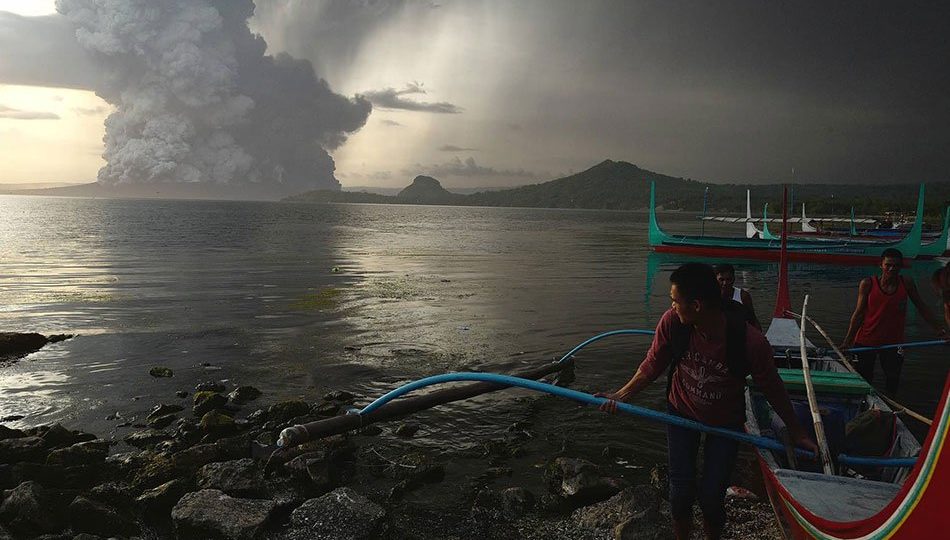The Philippine Institute of Volcanology and Seismology (PHIVOLCS) announced this morning that an alert level 4 remains over Taal Volcano, the underwater volcano in Batangas province that started spewing ash and steam on Sunday afternoon, leading to an evacuation and bringing ashfall to areas as far as Bulacan province.
Taal’s phreatic, or steam-driven, eruption began at 1pm yesterday, and by 2:49pm had progressed into a magmatic eruption, or a fountain of “weak lava accompanied by thunder and flashes of lightning.” An alert level 4 (5 being the highest, and indicating a full-blown eruption) indicates a sustained increase in sulfur dioxide emissions resulting in ash explosions, with danger zones extended up to nine kilometers from the active crater.
As of PHIVOLCS’ bulletin this morning, a “hazardous explosive eruption is possible within hours to days.” The agency reiterated that a total evacuation of the island is necessary, and warned that tsunamis could form within a 14-kilometer radius of the volcano’s main crater.
The agency had recorded a total of 75 volcanic earthquakes from the volcano as of 5am today. Of the 75, 32 were felt with intensities ranging from level II (slightly strong) to level V (moderately strong) in Tagaytay City; Cabuyao, Laguna; Talisay, Alitagtag; and Lemery and Bauan, Batangas. Over six thousand people have been evacuated from Taal island so far, and no casualties had been recorded as of this morning.
LOOK: Taal Volcano spewing a giant ash column after the phreatic explosion recorded at 1:00 p.m. Video courtesy: Danny Ocampo pic.twitter.com/lhzE12jghY
— ABS-CBN News (@ABSCBNNews) January 12, 2020
According to the National Disaster Risk Reduction and Management Council (NDRRMC), ashfall has been reported in the nearby provinces of Calabarzon (Cavite, Laguna, Batangas, Rizal, and Quezon), as well as in a number of cities in Metro Manila. Larger ashfall particles measuring up to 64 millimeters, or close to three inches, in diameter have fallen in Tagaytay City; Tanauan and Talisay, Batangas; and Sta. Rosa, Laguna.
In its bulletin this morning, NDRRMC has warned that fine ashfall can cause irritation and breathing problems, especially among the elderly and children. It advised people who smell a sulfurous odor to use N95-grade face masks, a wet cloth, or a towel to avoid inhaling the noxious scent. Motorists were also advised to drive carefully because wet ash can make roads slippery and cause poor visibility.
As of this morning, the town of Talisay has been covered in thick mud after the volcanic ash became mixed with rain. Ash has coated roads, cars, homes, and buildings, as seen in a video taken by ABS-CBN News’ Jonathan Cellona.
Balot na ng makapal na putik ang kalsada sa Talisay, Batangas at nabuwal na rin ang ilang puno dahil sa ashfall dulot ng pagputok ng #TaalVolcano.
Wala na ring kuryente at suplay ng tubig ang ilang residente, habang patuloy ang paglikas ng ilan. Jonathan Cellona, ABS-CBN News pic.twitter.com/IOwDaYl6QG
— ABS-CBN News (@ABSCBNNews) January 12, 2020
Classes and government office work have been suspended today in Calabarzon, the National Capital Region, and Central Luzon. Meanwhile, the government has also urged the private sector to suspend work in the affected areas for the safety of their employees.
Almost 170 flights have been suspended, and three have been diverted from the Ninoy Aquino International Airport, ABS-CBN News reports. Civil Aviation Director General Jim Sydiongco said that this was necessary because ash clouds are dangerous for aircraft.
“Once it enters the plane’s engine, it can cause damage, a flameout, or stalling. Volcanic ash can’t be detected by the aircraft’s radar,” he said. Sydiongco added that ash clouds can reach up to 55,000 feet, and would make it difficult for pilots to see the skies at night.
The Department of Health has urged people to stay indoors and to keep their windows and doors shut. The public was also told to use damp curtains to keep fine ash from entering their houses in areas where ashfall occurs. The Health Department also advised the public to protect their skin and eyes from ashfall by wearing protective clothing and goggles. The volcanic ash carries carbon dioxide and flourine, which the department said may cause irritation of the eyes, nose, and throat, and could also lead to respiratory problems such as coughing and difficulty breathing.
Meanwhile, the Philippine National Police (PNP) announced this morning that they will be deploying additional personnel to the Calabarzon region and towns in Luzon that were blanketed by ash.
In an interview with radio station DZMM this morning, PNP officer-in-charge Lt. Gen. Archie Gamboa said that they would also assist in ongoing evacuations, and would deploy seven trucks that can carry up to 80 people per trip to towns and villages threatened by Taal. Gamboa urged the public to brace for the eruption and to be aware of emergency hotlines and notices of evacuations.
Taal Volcano, which sits in the middle of Taal Lake, is a popular tourist attraction site in the Philippines. The volcano last erupted 43 years ago, in 1977.
Read more Coconuts Manila articles here.




